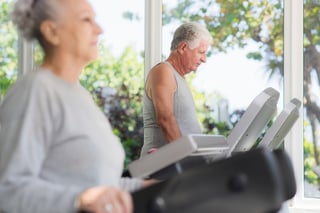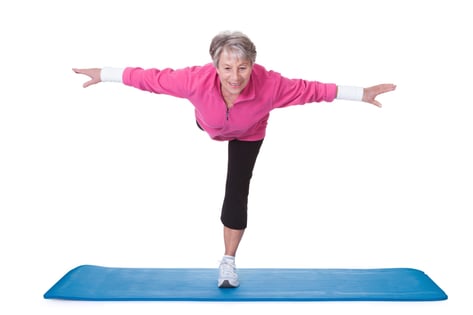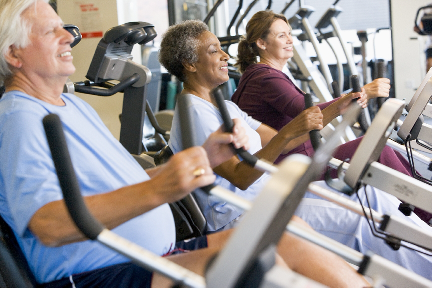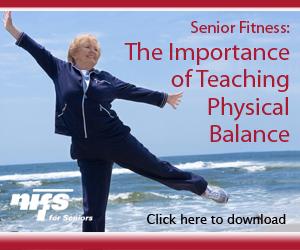 This blog was updated on March 22, 2017.
This blog was updated on March 22, 2017.
Of course, exercise comes with inherent risks. Fortunately, the scientifically proven benefits for regular activity far outweight potential risks for injury. And yet, for older adults, the risk of injury may be more pronounced, as the body is more prone to falls and other injuries from working with machines. So how can staff working with older adults decrease the risk of injury for their clients?
[Related Content: 5 Senior Friendly Equipment Ideas that Won't Break Your Budget]
Working with the senior population has taught me a great deal about injury prevention and risk that is important in the clientele. For example, not every piece of equipment is safe for every individual, regardless of skill and ability and safety should be the first consideration when determining the needs of each client.
Following are tips related to five common pieces of equipment we use with our older adult clients on a regular basis.
The Treadmill
One of the most commonly prescribed exercises for seniors is walking. It is an activity that can be done every day, and there is evidence to suggest it helps lower blood pressure, reduces stress, and helps maintain lean body mass. For the senior population, it is especially important to make sure each client is safe from falls and injury. Teach clients to look forward at all times, keep the arms swinging normally as they would on a walk around the block, and slowly increase treadmill speed with comfort. For more on treadmill safety, check out this checklist of safety tips for treadmills.
The Bike
An indoor bike and outdoor bike are similar in that they require proper adjusting prior to use. For a recumbent bike, remember to adjust the bike in a good position so that your client's feet are not reaching too far forward when pedaling. Make sure to adjust the back seat (if possible) to support good posture during the ride. Sometimes it's a challenge to maintain good posture due to aching backs or medical procedures. In that case, make the client as comfortable as possible, shorten the ride, or try another option for cardiovascular exercise.
The NuStep
Adjusting the NuStep for clients involves similar steps as noted above for adjusting the bike. Make sure that the client's feet are not reaching too far forward so that while pedaling there is a slight bend in the knee. In addition to these adjustments, consider talking the client through how to set their time and pace to enjoy an individualized ride. The NuStep is one of the safest pieces of equipment for seniors, and it can give a great workout for the upper body, lower body, or a combination of both.
The Selectorized Strength Machines
Adjusting the weight machines requires a good attention to detail, especially for the senior population. Some machines require adjusting seats, legs, arms, and back rests, and you will also need to adjust the weight stacks. For any senior starting out on exercise machines, it is best to have an exercise specialist adjust the settings for a customized workout. Take care to teach the client how to manage the settings when possible so that you're fostering independence in the workout. However, for many older adults working with selectorized strength equipment is a brand new activity and you may need to work with a client over a few fitness center visits in order to help them feel increasingly comfortable with the workout.
The Biodex Balance System
Adjusting this machine requires primarily knowing where to place your feet each time you step on it. As a critical aspect in senior fitness, balance training will help work on using both the brain and the body to prevent falls. With a correct adjustment on a balance machine such as the Biodex balance training system, clients will be ready to safely explore this aspect of your training to help prevent and reduce falls.
***
If you're preparing to purchase new equipment for your community fitness center, be sure to download our whitepaper on the key questions to ask during the buying process. Exercise equipment is expense; the whitepaper will help you be a more informed consumer.


 You might know that some of the basic elements your senior fitness workout program should include are weight training, cardio activities, and as much flexibility as possible. One element that needs special attention among the senior population is
You might know that some of the basic elements your senior fitness workout program should include are weight training, cardio activities, and as much flexibility as possible. One element that needs special attention among the senior population is 
 Now that the less obvious tips have been addressed in
Now that the less obvious tips have been addressed in 
 Have you noticed your parents sitting more and more? Throughout the aging process we tend to become less physically active, therefore decreasing our overall strength. This can lead to many health issues, including loss of balance and eventually falls. Falls in seniors are the number-one cause of fatal and nonfatal injuries. As we all know, the older we get, the harder it can be to recover from any type of injury, so let’s help mom and dad prevent what could potentially alter, or even take, their lives.
Have you noticed your parents sitting more and more? Throughout the aging process we tend to become less physically active, therefore decreasing our overall strength. This can lead to many health issues, including loss of balance and eventually falls. Falls in seniors are the number-one cause of fatal and nonfatal injuries. As we all know, the older we get, the harder it can be to recover from any type of injury, so let’s help mom and dad prevent what could potentially alter, or even take, their lives.
 Physical activity and exercise are two different terms that have similar concepts. Physical activity such as gardening, walking the dog, mowing the lawn, shopping, and taking the stairs gets your body moving. Exercise is a form of physical activity that is specifically planned, structured, and repetitive, such as strength training, yoga, or aerobics class. Both physical activity and exercise are great for seniors to keep up the daily activities they enjoy.
Physical activity and exercise are two different terms that have similar concepts. Physical activity such as gardening, walking the dog, mowing the lawn, shopping, and taking the stairs gets your body moving. Exercise is a form of physical activity that is specifically planned, structured, and repetitive, such as strength training, yoga, or aerobics class. Both physical activity and exercise are great for seniors to keep up the daily activities they enjoy. One of the most overlooked factors of physical fitness is balance. This is especially important for the senior population, but balance is something every age group should think about. Balance is important in order to remain upright and steady when sitting up, standing, and walking. We utilize balance constantly in our daily routines without even thinking about it.
One of the most overlooked factors of physical fitness is balance. This is especially important for the senior population, but balance is something every age group should think about. Balance is important in order to remain upright and steady when sitting up, standing, and walking. We utilize balance constantly in our daily routines without even thinking about it.
-resized-600.png?width=302&height=142&name=c--users-kgootee-dropbox-bc_(2012right)-resized-600.png)

 The number-one challenge that the aging population faces is balance because the number-one concern is
The number-one challenge that the aging population faces is balance because the number-one concern is  If you’ve spent time in a gym, you know “that guy,” the one who doesn’t work his lower body and just focuses on upper body. Lower-body strength training is just as important as upper-body. The largest muscles are located in the lower body. Working larger muscles tends to get your heart rate up higher and burns more calories. More important, the muscles in the lower body are used for everyday movements and help with balance and coordination.
If you’ve spent time in a gym, you know “that guy,” the one who doesn’t work his lower body and just focuses on upper body. Lower-body strength training is just as important as upper-body. The largest muscles are located in the lower body. Working larger muscles tends to get your heart rate up higher and burns more calories. More important, the muscles in the lower body are used for everyday movements and help with balance and coordination.